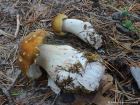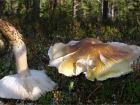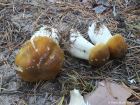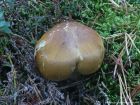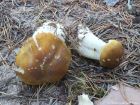Cap at first convex with a central bump, becoming broadly convex to broadly bell-shaped. It is dry with finely, radially appressed-fibrillose texture, featuring brownish yellow fibrils on a yellowish ground or, near the margin, on a whitish ground. The centre is usually darker and more brown. Gills whitish, attached to the stem by a notch and are close together. Short-gills are frequent. Stem equal or swollen in the middle, bald, and dry. It is whitish in color and develops brownish stains in places. Spore print white.
Microscopic Features: Spores measure 4–6 x 3.5–4.5 µm and are ellipsoid with a small apiculus. They are smooth, hyaline in KOH, and inamyloid.
Tricholoma arvernense on the MushroomExpert.Com Web site.
The second photo is by Irene Andersson under the Attribution-ShareAlike 3.0 Unported license.
Many mushrooms are poisonous, and some can be lethally toxic. Distinguishing between edible and poisonous mushrooms can be very challenging. Therefore, we strongly advise against consuming wild mushrooms. This website does not contain any information about the edibility or toxicity of mushrooms.
Although efforts have been made to ensure accuracy on this website, the information may contain errors and omissions. Therefore, all content provided is for educational and informational purposes only and should not be relied upon or used as a basis for consuming any plants or mushrooms.
External links are provided for reference only. We do not endorse or take responsibility for the content, advice, or products found on these sites or in any advertisements shown on this website.
